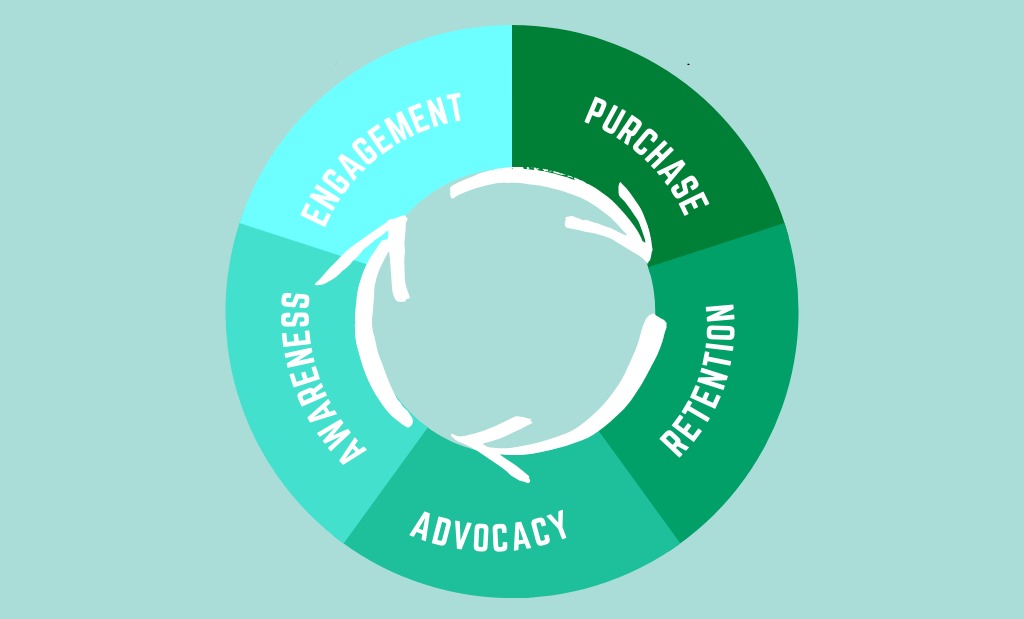What Is Lifecycle Marketing?

Repeat business has always been an essential part of business strategies. Yet, with companies gravitating towards online retail, a new concept has risen – customer lifecycle marketing.
Lifecycle marketing focuses on satisfying customer’s needs at a high standard at all stages of the customer journey. This enables engaging new customers as well as retaining a loyal customer base consistently and simultaneously.
Customer's Buying Journey. Stages
There are several customer journey stages – awareness, engagement/consideration and evaluation, purchase, retention, and advocacy. Lifecycle marketing focuses on each and all of them. Sometimes it is called a lifecycle marketing funnel, as at each stage, the amount of customers narrows down.
The post-purchase stages' main idea is to increase loyalty and make customers return to the sales stage again and again. This loyalty should persist regardless of any structural changes in the business. So, a customer base remains retained even when the business goes through re-organization.
The digitalization of sales has changed the components of customer retention. For example, regular app usage is a good indicator of loyalty, yet, the same customer who is reading articles might still not be buying products. Understanding the usage statistics of your customer base is absolutely necessary for creating a marketing lifecycle.
Let’s look at each stage and explore the best lifecycle marketing campaigns you can apply for your business.
Awareness
Awareness is the first stage of the customer journey. It is a phase when customers understand they need a specific solution and start actively researching which business can resolve it. It can relate to goods, services, or any other products. The business's primary focus is making the potential customer aware of their existence, informing them that the business can deliver the solution to the customer’s request.
From the marketing lifecycle perspective, awareness is a stage where many marketing campaigns start. These usually are more general campaigns, intending to inform the brand’s existence and attract new customers to the brand.
For example, it is common to raise brand awareness through collaborations with other brands and celebrities. A popular solution in modern days is collaborating with influencers on social media platforms. Social media are a powerful marketing tool. Apart from the general advertisement, they also offer such specific channels of awareness distribution as giveaways. Newsletters for those who have signed up are also a great way to increase acquaintance with the brand’s goods and services.
This is a stage where classical marketing techniques are used to attract new customers and increase brand popularity.
Engagement and Evaluation
This step can also be called “consideration” or “interest”. This is where a potential customer is aware of what you have to offer and considers options. The research is not over yet, as this is where prices, quality, delivery costs, and other specifications get compared with other eCommerce stores. It is crucial to provide as much as possible information about goods and services at this point so that customers can learn if this is what they have been looking for.
Simultaneously, a number of other practices can be done to get the customer engaged even if they decided to pass on the purchase this time. Offering registration and bonuses, new user tutorials and greetings, vouchers, wishlists, recommended items based on search results.
All of this is intended to create a sense of attachment between your users and your eStore. At this stage, it is essential to ensure that UI is serving customer needs and the software supports life cycle marketing.
Purchase
This is where a traditional sales funnel leads. However, this is only a middle stage; further customer journey is just as important. Thus, many things are done differently between various marketing systems.
In the eCommerce lifecycle marketing approach, it is vital to provide a satisfying purchasing experience. Using strategies to reduce shopping cart abandonment will boost sales and preserve the customer base if applied correctly.
Previous customers' reviews, coupons, free trials, and returns will encourage users to commit to a shopping experience. Using social media platforms and influencer’s recommendations of the shopping experience is important at this stage too. This can be a final drop to convince customers that their purchasing process with be easy and pleasant, followed by a quick delivery and good communication.
Retention
It is potentially the most crucial stage in eCommerce lifecycle marketing. It is approximately five times cheaper to retain an existing customer than obtain a new one. Once enough trust for first-time shopping was acquired, you should maintain and increase it for the customer to keep coming back.
One of the ways to increase customer retention is to gather feedback so you can understand your customer. Emailing campaigns and newsletters are essential at each stage. However, at this stage, after the sale has been incurred and the customer’s behavior has been studied, it is possible to create much more targeted and customized email campaigns. Some research states that custom emails are 18 times more efficient than general emails! So, data analytics on customer behavior and search history can provide a large information base for marketing customization.
Sending emails to remind about items in the wishlist or unpaid items in the basket is a great way to get customer attention. Another good option is to provide customers with the ability to sign up for a notification when the desired item is back in stock.
Besides, customer loyalty should be acknowledged. Vouchers and discount codes, and free shipment offers will always drive customers to come back to the eCommerce that suggests it, especially if they were happy with their previous purchases.
Advocacy
This phase is final in eCommerce lifecycle marketing. This is the end of the customer journey and the hardest one to reach. This is when a customer becomes an advocate of the brand and recommends it to friends, family, co-workers, social media followers, and any other contacts. This is where a customer is genuinely attached to the brand and wants to share it with other people.
To get here, customers have to be nurtured at every single stage before this one. They should feel valued, respected, and heard. They should be satisfied with the product or service and communication, delivery, timing, and question answering. Failing at even one of the previous stages will compromise customers' chances of spreading good opinions on your brand and giving free marketing.
Of course, the most crucial element is providing a genuinely good product or service that will encourage people to speak of it. Referral and mouth marketing are compelling – especially for small and family-owned businesses, where a customer is close to the seller. This makes people want to recommend their favorite brand to support it – and it's never too late to ask your customers to spread the word.
Creating this private atmosphere between the seller and the buyer, when they feel like they know the owner is possible not for small business only. Communication can be established at any scale. It is just necessary to make your customers feel that they are being heard.
Here are a few ideas of what an eCommerce store can do to boost customer advocacy. First of all, a rewards system, which offers pricing and other potential benefits to the customers. It is essential to make customers aware of available rewards systems and inform them of the milestones achieved. Messaging, emailing, and creating UI supporting the rewards system are all lifecycle marketing fragments at this stage. It is also a good idea to greet customers with their birthdays and other important celebrations – just as you would if your friend would walk into your store. Offering rewards for friends referral is another excellent strategy element.
At the same time, strategies from previous stages should be maintained, such as newsletter, updates, vouchers, rewards, and discounts. Making your customer feel valued will make them appreciate your business – and tell others about it.
Lifecycle marketing vs. Sales Funnel
Now that we have looked at lifecycle marketing in detail, let's outline the main differences between eCommerce lifecycle marketing and sales funnel.
Sales funnel is an alternative and older eCommerce strategy that focuses on customer behavior until the sale is made. Purchase, in this case, is usually the final step in the customer journey, and there is no focus on post-purchase behavior. This can be suitable for specific business types, and it might seem less challenging to implement than lifecycle marketing.
First and foremost, the sales funnel focuses on sales, while lifecycle marketing emphasizes a customer. The sales funnel usually has more aggressive paid marketing, targeting as many people as possible. The primary marketing strategy of the sales funnel is maximizing the reach out and sales quantity.
So, there is no need to work on product and service quality as much as with lifecycle marketing since there is no focus on bringing customers back for repeat purchases or encouraging them to spread the word about the business. It is potentially cheaper to implement. However, as with any online business, costs might vary significantly. It is impossible to say whether lifecycle marketing or sales funnel is better – they respond to different business models. However, lifecycle marketing is a more recent approach and does correlate with modern business strategies.
Lifecycle marketing may seem more ethical than sales funnel. However, the lines between them blur. At the end of the day, any marketing has increased sales and customer persuasion at its core. Several ethical questions arise from pushy and aggressive sales, and many companies are coming out of that marketing strategy now.
Conclusion
It is clear that lifecycle marketing is more sustainable, and it does involve a mutually beneficial relationship with the customer base. It is also more suitable for modern business frameworks, considering how much time and resources go into the brand’s online presence, UI, and data analytics.
Research, preparation, and implementation of a lifecycle marketing campaign is a complex study. At WiserBrand, we are always happy to provide you with the knowledge and resources and successfully launch and maintain a lifecycle marketing campaign.
